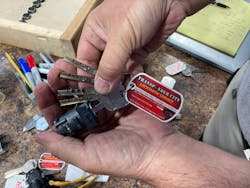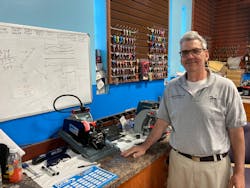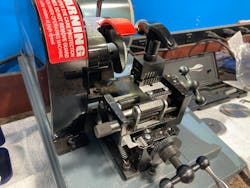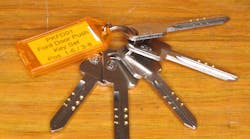Like many automotive locksmiths, Thomas Thill ran into some trouble one day on the job. Thill remembers the job as though it happened yesterday.
“The Toyota eight-cut ignition with the split wafers,” he says. The tool he used to decode the ignition simply didn’t work with split wafers and quickly got jammed to the point where Thill’s fingers hurt from trying to get the tool to move. Vise grips didn’t work either.
“Now, the next car I get, am I going to put this tool in that lock?” Thill asks rhetorically. “I am not going near it. I’m like, ‘there has to be a better way.’”
Sure enough, Thill, who is in charge of education and training at Transponder City, an automotive locksmith shop in the Chicago suburb of Bridgeview, Illinois, came up with “a better way” to decode and unlock Toyotas that had the eight-cut ignition, as well as hundreds of other vehicles: the Push Key.
Thill has used push keys for decades and has made and sold the tools to locksmiths on an individual basis. Now, through a relationship with Framon Manufacturing, Thill’s ready to take his method for decoding automotive wafer locks to the masses.
The first sets of push keys were made available through Framon in time for the ALOA annual convention in July 2022. Phil Agius, vice president of sales and marketing for Framon, says the company is “tip-toeing” into the making of push keys to start.
How did Framon get involved? Thill, who is a longtime owner of a Framon #2 key machine — more on that in a bit — recently discovered that Framon makes more than just key machines.
“I called up Phil,” Thill says. During the course of a conversation about keys, Agius mentioned that Framon made keys in quantity for newer model vehicles. “That’s when I said, ‘Hey Phil, maybe you can make THESE keys,’ and that’s how everything started with me and Phil talking, because I didn’t know he made keys; I thought he made machines.”
Hit and Miss Tool
Push keys are a way to decode cylinders and cut keys for automotive locks without taking apart the lock cylinder. A push key is a marked key blank that has a tiny notch cut into the tip at various depths depending on the keyway. When inserted into a cylinder that has wafer tumblers, the notch makes contact with a wafer or not depending on the wafer’s depth.
Depending on the location of the notch, those hits will provide the height of the wafer and, thus, the depth of the corresponding key cut.
We tried several push keys, and even novice locksmiths should be able to tell the difference between a hit and miss right away.
In addition to the notch, the push key also has a series of markings and numbers along the side of the blade that allow you to identify the wafer position in the cylinder when you have a hit as you insert the key.
Thill demonstrates how the system works by using a set of five push keys on a seven-cut ignition lock on a Ford van, where the first position is empty. His push keys have color-coded markings for positions 2, 4, 6 and 8 on one side of the key blade and 3, 5 and 7 on the other.
Starting with the No. 1 depth push key, Thill gets hits on all seven positions. After jotting down marks on his key grid, Thill moves to the No. 2 key, noting hits on positions 2 through 6 and then 8, before proceeding to No. 3 and so on until he identifies a code of X5544312 for that particular ignition. By putting the odd-number locations on one side and even numbers on the other, Thill then can cut a key that turns the ignition.
Although Thill typically starts with the No. 1 key, he suggests that starting with the push key for the deepest cut first could help to speed the decoding process. As seen in the above example, a No. 1 key when used first could mean the wafer height could be anything from a 1 to a 5, because the shallowest cut push key will hit every wafer — assuming the wafer exists and is intact. (Starting with the No. 1 key will tell you right away whether a problem exists with the cylinder, Thill says.)
However, getting a hit on a No. 5 key automatically means a depth of 5, because wafers that are taller won’t hit on a 5. Getting a hit on a No. 4 key means the wafer is either a 4 or a 5, but, because you already used the 5 key, you know that any hits not already marked on your grid are a 4, because they didn’t register a hit with the 5 key.
“If it’s not ‘new information,’ leave it alone,” Thill says.
The progression follows logically from there.
Push keys work on single- and double-sided keyways and on sidewinder, or high-security automotive, keys as well. However, sidewinder keys require two sets of push keys — one for the left track and one for the right track.
Note the Differences
Push keys are similar to Lishi 2-in-1 tools in the sense that different vehicles and different keyways require their own push keys to operate correctly. In other words, push keys that work on a Ford van won’t work on a Chrysler.
For example, Nissan groups its wafers in pairs, so wafers that have key depths of 1 and 2 sit at the same height and 3 and 4 sit at the same height. Thill calls this a high-low system. There also are “odd-even” systems that do the same thing but with depths of 1 and 3 and 2 and 4 in separate groups. Other systems are even more complex.
This results in two things:
- Different keyways might require the use of a different number of push keys to decode the lock.
- Using push keys to decode a lock might not be as straightforward as in the above Ford example.
That doesn’t mean that the push-key system doesn’t work, just that a little more work might be necessary to decode the keyway. In some cases, you have to “be a locksmith,” Thill says.
This would require some knowledge of the keyway in question and how the manufacturer set it up as well as performing some impressioning — and cutting an extra key blank or two.
In the above Nissan example, Thill would use a push key to determine whether it was a high- or low-hanging wafer. If the push key made a hit, it was a high; if it missed, it was a low.
That isn’t enough information to cut a key, of course, but it’s a start.
“On the push keys, we’re trying to use the lock to give us as much information that we can use in a rapid fashion,” he says.
He then brings half-cut impressioning to bear. Thill makes two keys that have half cuts — one that has a depth of roughly 1-1/2 for the low wafers and the other 3-1/2 for the high.
By inserting the test blank and taking advantage of the tolerances in automotive keyways to turn the lock just enough to mark the key, Thill then can determine on each key whether each position has a key depth of 3 or 4 depending on whether a mark is made on the key: A mark means it’s a 4; no mark means it’s a 3. The same is true for the other key: A mark means it’s a 2; no mark means it’s a 1.
The same system works on other configurations, but it might require the use of additional test key blanks, depending on the manufacturer. For example, Mercedes-Benz uses a high-low system that has five depths, so three test keys are necessary: one for the lows, one (at 3-1/2) to determine 3 depths and one (at 4-1/2) to determine 4 depths.
It also might require the use of a Lishi tool in the case of an odd-even system where the push key determines odd or even numbers, and the Lishi reads the depth, which is easier and more accurate when the differences — a 1 compared with a 3 vs. a 2 — are larger.
“They fit together,” Thill says. “How do you make a key for a high-security GM? You need two tools. ‘Why do I need two tools? How come one tool can’t do it?’ Because it doesn’t.”
However, push keys won’t work on residential or commercial locks because of the complexity of pin tumbler locks.
Making the Push
Framon is producing only a few series of push keys for Ford vehicles to start, and although Thill says any push-key system he has created could be back-ordered, Agius isn’t too keen on building up his company’s back-order list.
The alternative for the time being is to make your own push keys, and this is where Framon’s #2 code key machine comes into play.
Thill says any key machine that allows for the use of a slotter, typical in the making of keys for safe-deposit boxes, might work, but he prefers the Framon #2, because locksmiths can make precision adjustments to .001 inches to the x and y axis of the key vise. The precision is what makes push keys possible.
Framon’s push keys come with a notch that has a depth of .010 inches to contact the wafer. However, Thill says different locksmiths might require a different notch size.
“It’s kind of like buying a pair of shoes: Is it the right size for you?” he says. He says he’s shown push keys where the notch is .005, .010 and .015 inches. “I’ll say ‘try this key.’ They’ll say, ‘I don't feel anything.’ All right, so I know you’re not a ‘five.’ Try the 10. It’s a custom tool, you would say.”
We tried several push keys of different “sizes,” and can vouch for the difference in feel. A “five,” where the notch is barely perceptible, slides easily into a corresponding cylinder, providing plenty of control to make clear hits at the wafers. A “10” was a little bit more difficult but still reasonably controllable. A “15” required some wiggling to be able to move past wafers and go further into the cylinder.
“Minus 20, that’s a real heavy hand,” Thill says. “Minus 25 is next to impossible.” Thill says the “10” is likely the best fit for most locksmiths.
How one determines where to put the notch depends on the keyway. For example, Thill imagines a keyway where the No. 5 depth is .220 inches.
“The push key has to be higher than .220 to contact the wafer.” So, he makes the notch for the No. 5 push key at .200 to .210. “Now, you have a .010 ledge that will make contact with the wafer in there. You can make those adjustments accordingly with the other depths.”
Locksmithing knowledge and experience is brought to bear here, too. For the most part, a No. 1 cut is near the top of the key blade and a No. 5 is near the middle, and a certain amount of depth in the middle on double-sided keys is necessary to keep the key blade from breaking.
As far as sussing out the wafer positions and making the marks on the side of the push key, that comes from “the feel” when you insert the key into the cylinder. When the notch contacts a wafer, Thill marks the spot on the key blade that’s just outside the lock face with an etching and later colors each mark. He does this each time there’s contact, remembering to flip the key to note odd and even locations as necessary. He also marks the order of the colors on the key head as a reminder.
“If they’re all the same color, it’s very confusing,” Thill says. “If you put the key in, and it stops on a green, stops on a yellow, stops on a red, you’re going to remember that. It’s all about getting accurate information out of the lock cylinder without taking it apart.”
For more information, go to www.framon.com









